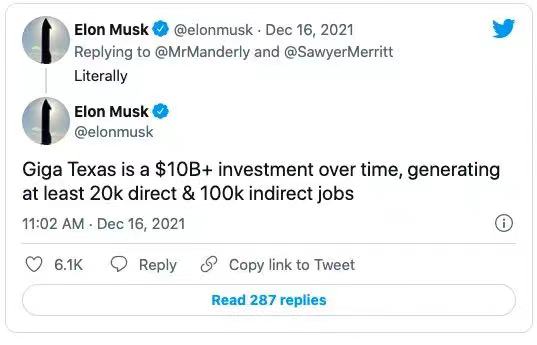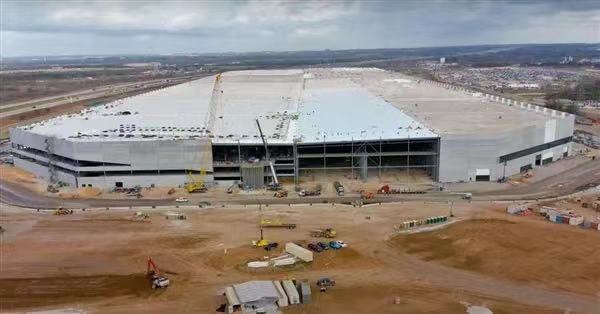Any day now, Tesla Inc. will start production at its Austin-area electric vehicle factory. It will be a major milestone for the company, with analysts calling it critical to meeting the ambitious goals of CEO Elon Musk.
The factory could also have a much larger economic impact in the Austin region than originally announced, according to Musk.
In a Dec. 16 exchange on Twitter, in response to criticism about public incentives for the plant, Musk said the factory will be a $10 billion-plus investment “over time,” and will create at least 20,000 direct jobs and 100,000 indirect jobs.

While it’s not clear if those plans will come to fruition, that could make Tesla (Nasdaq: TSLA) one of the largest or perhaps even the largest private-sector employer in the Austin area. As of July, grocery chain H-E-B LP ranked No. 1 in Austin Business Journal records with about 19,000 workers.
It is uncommon for Musk, the richest person in the world, or Tesla to divulge many details about future plans. But his latest prediction bolsters the case that the Austin area will play a key role in the future of Tesla.
Analysts who cover Tesla point to the factory east of Austin as critical to the company’s production plans.
“It’s a linchpin to its capacity buildout,” said Dan Ives, managing director and senior equity analyst at Los Angeles-based Wedbush Securities Inc. “We view the Austin buildout as the most strategic endeavor for Musk & Co. in the last five years.”
When Tesla announced in summer 2020 that it would build the plant in eastern Travis County, the facility was pegged as a $1.1 billion investment that would create around 5,000 jobs. Earlier this year, Musk said at least 10,000 workers would be needed by the end of 2022. Tesla intends to produce its Cybertruck, Model 3, Model Y SUV and Semi tractor-trailer at the factory.
Tesla also recently relocated its corporate headquarters to Austin, and Musk’s other startups such as tunneling company The Boring Company and brain implant startup Neuralink Corp. continue to build out in the region.
Ives, a Wall Street analyst for two decades and frequent guest on CNBC’s “Squawk Box,” said Austin is the “epicenter for Tesla” because of its HQ move and new factory.
“We believe Austin will be the core production artery for Tesla by 2023 and at scale we expect Tesla to hire another [3,000] at the Austin factory,” Ives said, prior to Musk’s recent Twitter post.

Musk confirmed during a recent interview with The Wall Street Journal that the factory was nearing completion. The company appears to have recently undergone a hiring surge. Just a few weeks ago, the company had more than 400 jobs posted on its website. By publication time, that had fallen to 167.
Seth Goldstein, a Morningstar Inc. senior equity analyst who covers Tesla, said that likely means the factory will begin production soon. But he added that it generally takes a couple of years for factories to near full production capacity.
“I would expect production to ramp up slowly over several years to the 500,000 [vehicle] per year level, in line with the initial capacity of the Fremont and Shanghai factories,” Goldstein said.
During the third quarter, Tesla delivered 241,300 vehicles, which topped expectations that the company would deliver closer to 220,900, according to CNBC. Tesla executives told shareholders in October that the company expects to achieve 50% average annual growth over the next few years, and it continues to target Model Y production in Austin before the end of the year.
Ives added that the Austin-area factory should be at “significant scale” by June 2022. That would be almost two years after Tesla announced it would build in eastern Travis County.
Tesla did not return requests for comment.
Tesla shares closed Dec. 16 at $926.92, up about 38% in the past six months. With a market capitalization of about $931 billion, Tesla is worth more than any other carmaker in the world. It had 70,757 employees worldwide at the end of 2020, according to its annual report filed with the U.S. Securities and Exchange Commission.
The Article is from Austin Business Journal, copyright belongs to owner





